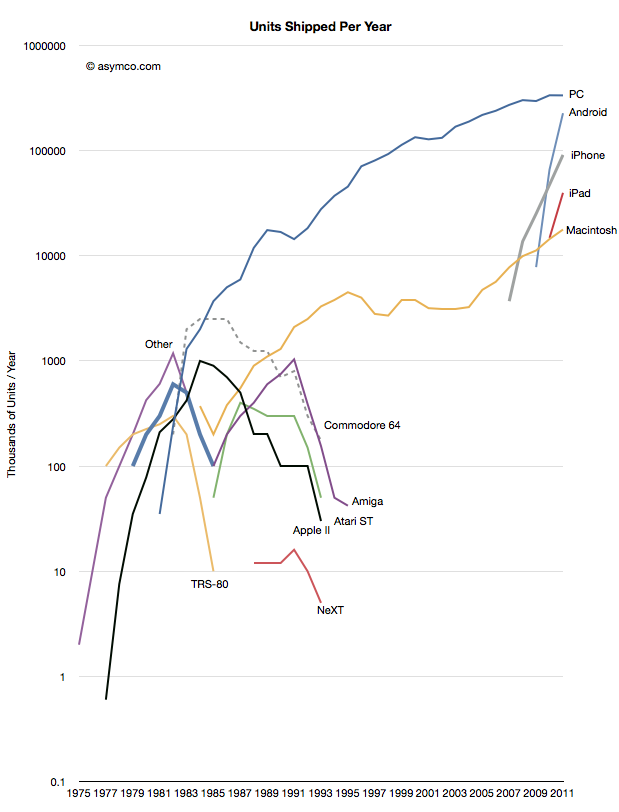This discussion makes me think about the implications of the above discussion to the 'potential and actual supply market for FAH'. By 'potential and actual supply market for FAH' I mean the amount of FLOPS donated by the total FAH community. To my knowledge, these factors have been tackled in the forums, but officially, have only been touched upon in the section five of paper 67 (
Folding@home: lessons from eight years of distributed computing). In my opinion they do have a significant impact on the future of FAH/DC...
As a starting point, holding all other thing constant, FAH increases because of Moore's Law + increasing number of global (internet connected) computers. If the number of global (internet connected) computers becomes constant, FAH increases because of Moore's Law.
Folding@home: lessons from eight years of distributed computing adds additional variables by considering the effect of publicity and paper releases, participant psychology (i.e. the effect of competition and altruism) and per-volunteer costs (which it sees as insignificant unless power prices increase rapidly in a geographical location).
However, the above discussion raises additional concepts, such as
what computers they will use in the future and
how users will use them.
What computers, such as a Desktop or a Laptop or a 'handheld device' (tablet/smartphone) is important as each has a different utilisation profile - Desktop = best candidate, Laptop = good candidate, handheld = poor candidate (at least in the current - immediate future). Changes in the total number of devices and in the proportion of each type will have impacts on the growth of folding.
In between What and How is the specialisation of computers and the increasing stratification of these categories, eg in the desktop PC category has evolved to range from low powered 'good enough' systems such as ATOM or Brazos for web browsing and word processing to high powered gaming rigs. No longer do you see a P4 or AMD equivalent in virtually every PC sold. Basically what we've already been discussing, but in effect, as people specialise their computers for a given task, there is relatively less excess for FAH to mop up.
How is just as complex. One could argue that
Per-volunteer costs are increasingly
less insignificant.
This is not a criticism of the above paper, or a suggestion that F@H does not value the investment by donors okay? Let us be clear that I for one know F@H values its users, I see it every time a staff member responds to me. One area in which per-volunteer costs are increasing is because offset against increasing power and increasing power efficiency/FLOP is the gains made in idle efficiency. Idle efficiency is the downclocking of cores, power gating, hurry up and get idle and faster start up/restore/wake times etc, and is arguably
one of the main ways manufacturers are improving power efficiency at the moment. As computers become more efficient at being idle, the delta in power usage between idle and full utilisation increases. This delta is amplified by real electricity prices increasing in most markets (in mine
real power prices have increased by 42% since 1992, that is 42% higher having adjusted for inflation). The result is the marginal cost of utilising idle processing power increases and this absolutely puts pressure on DC. As per-volunteer costs increases, DC becomes less unattractive relative to local computation. This would be manifested in it being more efficient to donate money to F@H and leave idle processing power idle than to simply fold for them. In this specific case, per-volunteer costs will always have to be less than the cost of local computation
minus any tax incentives regarding donation to a tax deductable charitable organisation (Stanford). Perhaps this can be seen, or measured, in terms of the shift to the Cloud. Or one might say more specifically, the re-centralisation of computing through PaaS, SaaS and IaaS...
Increasing numbers of computer devices per user (i.e. from One desktop or laptop each to one desktop or laptop and one mobile device) may increase the idle computational time on DC friendly devices such as the desktop, as tasks such as browsing are shifted from the PC to the smart phone, but conversely, may reduce the amount of time that DC friendly devices are powered on or 'awake', particularly if start up/restore/wake times decrease.
Quite how decreasing hardware costs interacts with that I'm not too sure. Perhaps it increases marginal per-user cost relative to the fixed cost of purchasing a computer, making utilising idle processing power less attractive. Perhaps it increases people's specialisation of devices. Perhaps decreasing hardware costs shortens the purchase cycle, meaning people future-proof their computers and have less idle capacity at the beginning of the products life-cycle. Perhaps is opposite to the three previous and it allows people to purchase computers over and above what is used!
Finally, intimately related to hardware costs is the second to last area I want to acknowledge in this post: software demands. Positively through innovation and negatively through bloat, increasing faster than hardware can supply. As 'active and user' applications directly influences the amount of idle processor power this too influences DC. I think software is still pushing hardware and pushing pretty hard, but I am not sure whether this is positive thing for FAH or a negative thing.
I am interested in hearing about what other areas people think will have an impact on DC.
...You did say discuss in the OP 7im

